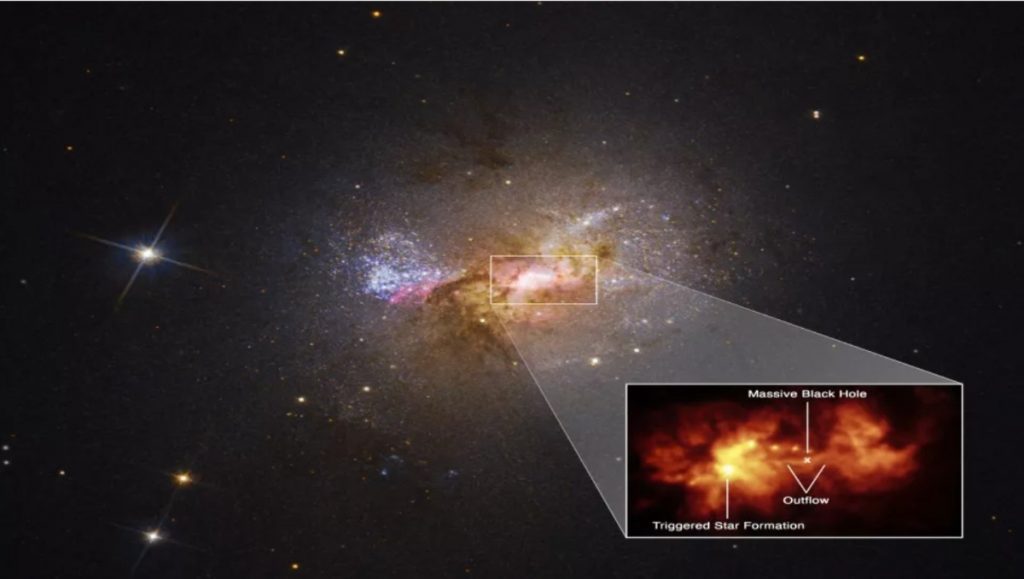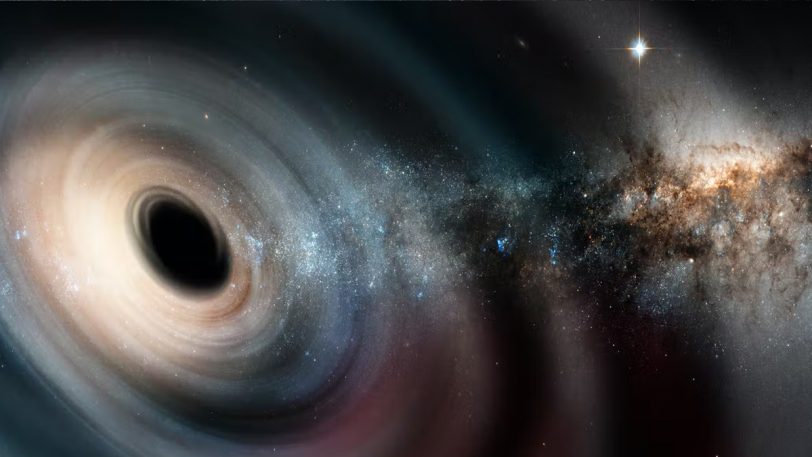Black holes are usually considered to be enormous, aggressive, and extremely destructive structures. However, according to recent research, they are just as capable of producing stars as they are of consuming them.
Astronomers have discovered a black hole “giving birth” to stars at the center of a nearby dwarf galaxy — and the stellar newborns are held together by a massive “umbilical cord” of gas and dust.
The supermassive black hole was seen spewing a 500-light-year-long jet of ionized gas from its center at around 1 million mph (1.6 million km/h), contributing to a “firestorm” of new star formation in a nearby stellar nursery.
According to experts,
the discovery, made possible by NASA’s Hubble Space Telescope, is the first time that black holes have given strong indications that they stimulate star formation in very small galaxies, raising the question of what role black holes play.
The remarkable finding was described in a study published in the journal Nature.
“From the beginning, I knew something unusual and special was happening in Henize 2-10, and now Hubble has provided a very clear picture of the connection between the black hole and a neighboring star-forming region located 230 light-years from the black hole,” study co-author Amy Reines, an astrophysicist at Montana State University, said in a statement. “Hubble’s amazing resolution clearly shows a corkscrew-like pattern in the velocities of the gas, which we can fit to the model of a precessing, or wobbling, outflow from a black hole.”
The jet’s thin tendril was observed
stretching out from the black hole and across space to a bright stellar nursery. Supermassive black holes, which are millions to billions of times the size of stellar-mass black holes, have previously been observed emitting cosmic plumes, but astronomers originally thought that these jets hindered rather than helped star formation in dwarf galaxies.

“At only 30 million light-years away, Henize 2-10 is close enough that Hubble was able to capture both images and spectroscopic evidence of a black hole outflow very clearly, lead author Zachary Schutte, a graduate student at Montana State University, said in the statement. “The additional surprise was that, rather than suppressing star formation, the outflow was triggering the birth of new stars.”
Black holes create the jets
that spew from them by sucking in material from nearby gas clouds or stars and slingshotting it back into space as blazing plasma traveling near the speed of light. If heated sufficiently, the gas clouds that collide with the jet will become ideal nurseries for future stars.
However, getting to that Goldilocks zone is critical; according to NASA, if the jets heat up the gas clouds too much, they may lose their ability to cool back down in the way needed for star formation. But with the gentle, less-massive outflow from the black hole in Henize 2-10 created ideal gas conditions for star formation.
Because this black hole
has remained relatively small over time, the researchers believe that studying it in greater detail will help them understand the smaller origins of larger supermassive black holes in the universe, as well as the processes that caused them to balloon to such massive scales. Furthermore, the team’s high-resolution method for detecting the black hole’s dim signature can now be used to find others like it.
“The era of the first black holes is not something that we have been able to see, so it really has become the big question: Where did they come from?” Reines said. “Dwarf galaxies may retain some memory of the black hole seeding scenario that has otherwise been lost to time and space.”
READ MORE:The Tiny Dots in This Image Aren’t Stars or Galaxies. They’re Black Holes






